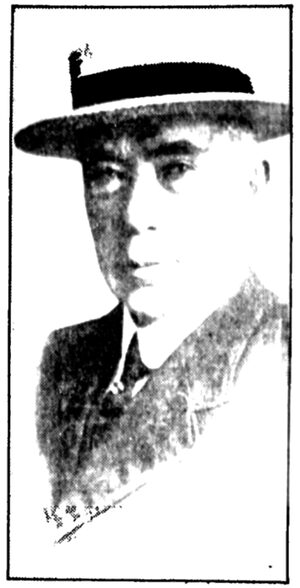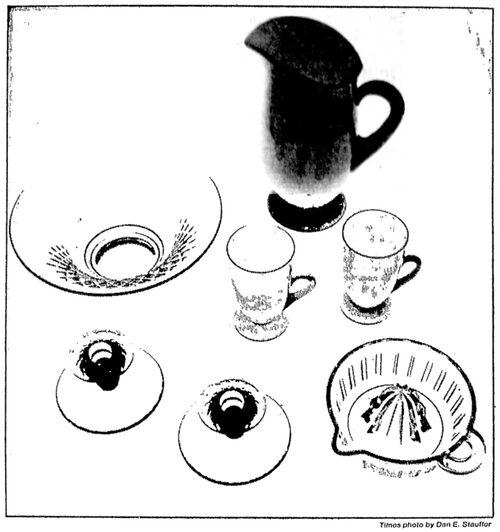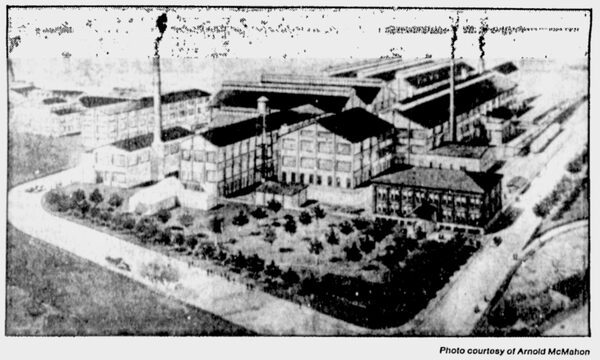[Newspaper]
Publication: Beaver County Times
Beaver, PA, United States
p. 1 Sect D, col. 1-6
Fry Glass
Everyday glassware
becomes a popular
collectible legacy
of a local craftsman
By TERRI GALLAGHER
Times Staff
New York Avenue in Rochester Township meets tiny, gurgling McKinley Run near a recently closed bridge. One might have trouble imagining that amid this subtle blend of grown-up weeds and redeveloped buildings stood the H.C. Fry Glass Co., a factory that historians once called "the most modern and best equipped factory in all the world."
| |||
| Henry C. Fry |
The tall brick stacks — where smoke and steam billowed more than 50 years ago — no longer stand, but the glassware produced there has become one of the most highly sought-after collectibles in the United States.
From 1901 to the early 1930s, when the plant closed, thousands of people — from immigrant master glass blowers to 14-year old boys hoping for apprenticeships — labored daily over glass pots and furnaces at the Fry works.
They produced a high-grade glassware ranging from cut-glass punch bowls and blown vases to tumblers and pressed casserole dishes.
| |||
| An assortment of Fry glass shows the company's versatility and craftsmanship. |
Working at the Fry plant, with starting pay of $2.50 a day in the late 1920s, was a good way for the men and women who passed through the factory's shops and storerooms to earn their living.
The employees probably did not realize how their work would live on, that in a half-century the lemon squeezers and baking dishes they produced — the latter selling for under $ 1 each — would someday be the catalyst of bidding wars at local auctions or the featured items in antique-store windows.
All wares manufactured at the Fry plant, whether daily ovenwares or cut glass, now are considered collectors' items.
Herbert Gold, owner of Herbert Gold's Antiques and Gift Shop, Erie, receives many inquiries from people who look for Fry glassware. "During the summer, tourists stop in looking for the glass," he says.
Gold, an authority on antique and collectible glassware, emphasizes that Fry glass is not an antique because it is less than 100 years, but is a good collectible.
The glassware is valuable not only because it is no longer produced, he says, but because of its unique blending of colors. "You will find a pitcher or stemware with both blue and amber," explains Gold, who also collects Fry's cut glass products. "The stem or handle may be blue while the body is amber. Fry Was a forerunner in this.
"The cut glass was of very good quality. The patterns were too numerous to name. Fry’s cut seems to be unique in its depth."
Employees probably did not realize that their work would become the catalyst for bidding wars at local auctions half a century later.
Henry C. Fry, the enterprising founder of the glass factory, distributed his products internationally. He is said to have obtained master craftsmen from Europe for glass cutting. The Fry company also had the first patent on a cut-glass pattern.
Fry cut glass is more valuable when signed with the Fry name. However, it is believed that only 10 percent of the cut-glass wares were marked with acid-etched script signatures.
If in mint condition, Fry cut glass commands a high price. Gold says; commonplace products that might have sold new for 19 cents now can bring as much as $25.
Members of the H. C. Fry Study Club, an organization of collectors in Beaver County, maintain that the prices of Fry glass, like other products, depend on availability, desirability and location. To them, it’s the old story of if you want it bad enough, you'll pay for it... and travel as far as Indianapolis to get it.
Fry glass products have been increasingly harder to find in recent years, says Judy Giangiuli, manager of Back Door Antiques, near New Castle. She claims that signed pieces and pieces from Foval (Fry Ovenware Art Line) sets are popular with collectors.
Foval glass is thin, smooth glassware opalescent in color, trimmed in Delft blue or jade green. Tea sets, coffee pots, candlesticks and vases were included in the Foval line. Foval glass or art glass is marked only with paper labels, most of which have long ago vanished. Other Fry ovenware bears several tradmarks [sic] trademarks and most are marked.
"If you have more than one piece to a set it usually sells faster than if you have only one piece. But it's all a matter of demand," says Giangiuli.
| |||
| An artist's rendering of the Fry factory in 1910. |
Marion Sankovic of Olde Attic Antiques, Zelienople, says she has seen a marked increase in the past several years in the collection of Fry wares. She believes that at one time, local residents probably had Fry glass but didn't know its value. However, with its rising popularity, people are beginning to realize that wasn’t just junk they had packed away.
Yet veteran local auctioneer Sherman Hostetter is not so sure of that. He says he still sees Fry glass at house auctions. In turn, he has seen more Fry collectors on the auction circuit.
Hostetter says collectors first became noticeable on the scene 15 years ago. Some admit, however, that they have hoarded Fry products for more than 30 years.
More than just the glassware itself is collectible, Hostetter adds. Anything touched by H.C. Fry himself or the Fry family is becoming valued locally. At an auction last summer, Hostetter sold the molds used for glassmaking at the Fry plant. Even time cards from workers in the plant are being collected.
The demise of the Fry factory was caused not by inefficiency but the times and national economy. Silver, not cut glass, had become the household item most in demand. Also, the continuation of Prohibition had reduced the need for glass.
The factory stacks ceased to stand decades ago. Only a few storage houses and one building, a squarish office structure of blood-red brick, are left intact. Even the insides of this lone memento have been converted to apartments.
But in collectable circles today, the Fry wares produced on that site command high values that can make a search through through Grandma's old everyday dishes a worthwhile venture.


